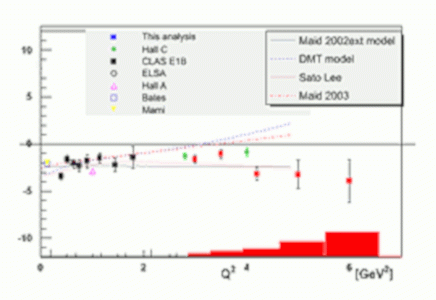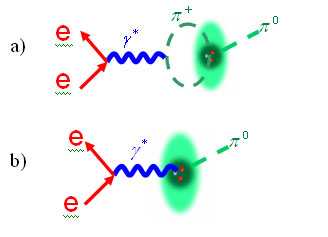Nucleon-Delta Transition

The ratio E2/M1 as a function of Q2.
Additional Links
One of the many success stories of JLab's resonance physics program has been what we have learned about the Delta resonance, which is the lowest energy quantum excitation of the nucleon. There are several ways the nucleon can be electromagnetically excited to the Delta. One, denoted M1, or magnetic dipole moment, gives us information about the distribution of the quarks' electric current within the nucleon and Delta. Another, denoted E2, or electric quadrupole moment, describes the deviation from sphericity of the quarks' electric charge distribution.

a) The pion cloud probed at long wavelengths. b) The nucleon core probed at high Q2 (high resolution).
In the simplest quark picture, both the nucleon and Delta are spherical objects, so that E1=0, and the excitation proceeds completely by M1. Experiments at JLab have shown, however, that the E2/M1 ratio is small but non-zero, suggesting that the nucleon and Delta are not perfectly spherical. The physical picture which this reveals is that the nucleon is a "core" of three quarks enveloped by a non-spherical "cloud" of pions, and photons often interact with this cloud rather than the core. The expectation is that at very high Q2, or short wavelengths, one penetrates the cloud and observes the core, which looks very different, so that E2/M1 should significantly change, even approaching unity at very high Q2.
The E2/M1 ratio has been measured at JLab up to the very highest Q2 ever recorded, corresponding to a resolution of less than 0.05 femtometers. Remarkably, E2/M1 doesn't change very much, but remains approximately constant at a small negative value. At this time, we do not yet understand what properties of the nucleon or Delta give rise to this behavior. There is evidence that further development of the theoretical tool called Lattice QCD may supply the answer.

